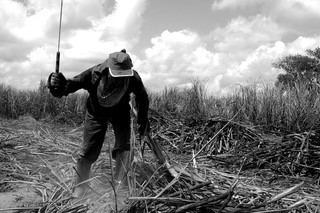 |
| Photo courtesy of Flickr contributor Cícero R. C. Omena |
Farm workers in Central America who are involved in weed or pest control, encounter rodents regularly, or drink or wash their hands with drainage ditch water may be at greater risk of suffering a puzzling kidney disease that has killed more than 20,000 people in Central America, according to a presentation Monday at #TropMed17.
Rebecca Fisher of Baylor College of Medicine reported on the latest results from an exhaustive study underway among several hundred farm-workers at a sugar cane plantation in Nicaragua that is a hot spot for a confounding epidemic of deadly kidney disease known as Mesoamerican nephropathy or MEN.
“This is an ongoing study, and we still don’t have any (clear) signs about which of these risk factors are the most important,” she said.
The sudden surge of MEN over the last 20 years in different parts of El Salvador, Nicaragua, Guatemala, Costa Rica, Honduras and southern Mexico has stumped disease experts because it differs dramatically from conventional chronic kidney disease. Previously, the condition was mainly seen in older people who also suffer from hypertension or obesity. And it usually features a slow onset. Meanwhile, most MEN victims have been young, otherwise healthy individuals who progress quickly—often in just a few months—from acute disease to full kidney failure.
Kidney failure is a death sentence for most of the victims, Fisher said, because they lack the resources for regular kidney dialysis, which is the only viable treatment option.
Fisher and her colleagues are following a large cohort of farm workers, tracking multiple factors to see if certain exposures or behaviors are different for MEN victims compared to co-workers who remain healthy. So far, they have found MEN victims are more likely to be involved in weed or pest control—applying herbicides or pesticides; more of them work as sugarcane cutters; and they are almost twice as likely to encounter rodents, either in the field or in their homes.
Also, more MEN victims reported using water that pools in irrigation ditches to wash their hands or to drink. They also were more likely to have a family member who has suffered from the disease.
“There does appear to be family clustering,” Fisher said.
She said there is no evidence that there is an inheritable genetic risk factor, but the issue of family connections could point to some type of “common exposure.”
One area that is getting further attention from the scientists is exposure to rodents. In addition to more frequent encounters in the field, MEN victims also were much more likely to report daily contact with rodents in the home. Rodents in the region are potential carriers of hantavirus and leptospirosis, both of which can cause kidney complications.
Fisher said thus far there is no evidence that occupational issues, like the numbers of hours or years worked or frequency of heat stress or dehydration are a risk factor. Asked about the possibility of pesticide poisoning, Fisher said the researchers have not yet collected enough data to make an assessment but “we hope to be able to tease that out.”
Fisher noted that the 20,000 deaths attributed to MEN thus far are likely a dramatic underestimation of the true impact because death records in many areas where the disease is common are poorly kept and do not track kidney disease as a cause of death.